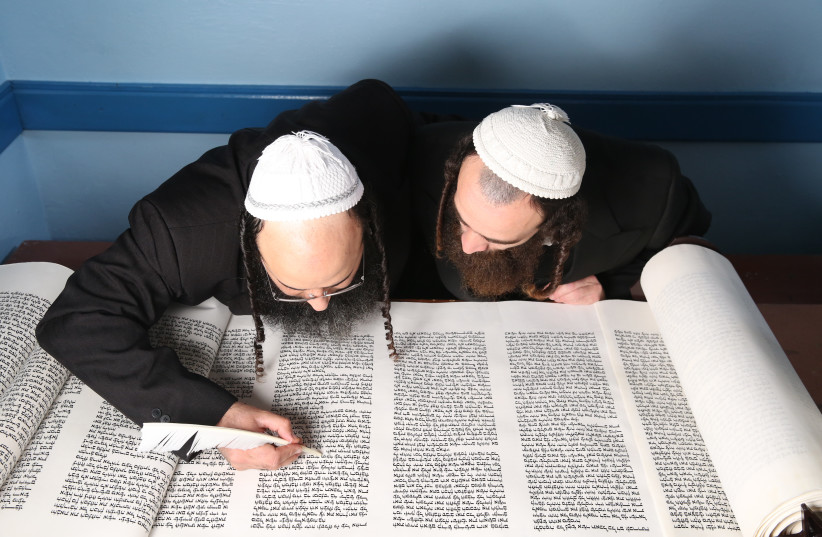Parashat Shmini: Our most important partnership with God

The connection the Talmud makes between the construction of the Tabernacle, a human event, and the creation of the universe, a godly event, is an association we want to further explore.
“And it was on the eighth day Moses called Aaron and his sons, and the elders of Israel,” opens this week’s Torah portion, Shmini (Leviticus 9:1). The Talmud uses this line in a classic multifaceted Talmudic discussion about the word “vayhi” (and it was) in an attempt to determine if the phrase portents woe or joy.
After presenting a number of biblical sentences supporting the former, the Gemara (the rabbinic discussion within the Talmud) turns to biblical sentences that understand “vayhi” in a more upbeat light. It is in that context we find the verse:
“But isn’t it written: ‘And it came to pass/vayhi on the eighth day’ (Leviticus 9:1), after a week of ordination events for Aaron and his sons as priests; the eighth day marked the dedication of the tabernacle. And it is taught: On that day, the eighth day, there was joy before the Holy One, blessed be God, similar to the joy on the day on which the heavens and earth were created.’”
The Gemara then applies a hermeneutical analysis called gezerah shavah (an inference drawn from identical words) in two passages to make its point. “It is written here, ‘And it came to pass/vayhi on the eighth day,’ (Leviticus 9:1) and it is written there, ‘And it was/vayhi evening, and it was morning, one day’” (Genesis 1:5, Megillah 10b).
Through this analysis, the Talmud establishes that vayhi can also indicate joy. For our purposes, the connection the Talmud makes between the construction of the Tabernacle, a human event, and the creation of the universe, a godly event, is an association we want to further explore.
In her deep and far-reaching commentary on the Torah, Nehama Leibowitz also notes that similarity. In her close reading of the text, she finds seven parallels between the creation and the Tabernacle:
- Made/make: Genesis 1:7;16;25; Exodus 25:8;10;23;31
- Six days: Genesis 20:11; Exodus 24:16
- Seventh day: Genesis 20:11; Exodus 24:16;18
- Finished: Genesis 2:1-2; Exodus 39:32; 40:33
- Saw – “God saw,” “Moses saw”: Genesis 1:31, Exodus 39:43
- Behold: Genesis 1:31; Exodus 39:43
- Blessed – “God blessed”, “Moses blessed”: Genesis 2:3; Exodus 39:43
Leibowitz then goes on to write in Studies in Exodus: “The Lord created the heaven and earth and all therein, for man to dwell in, and created them in six days and rested on the seventh day. Similarly, Moses was summoned on the seventh day to the cloud to see the pattern of the tabernacle that it was his duty to erect, in order to provide a place on earth for the Divine presence. It is incumbent on man to imitate his Creator, His ways and attributes and assume the role of being His partner in creation.”
Two profound lessons
There are two profound lessons we can learn from Leibowitz’s insight about imitating and being partners with God. The first is that we should see our work during the six days of the week as building a tabernacle – building space for God and godliness in our lives and our world. The second, which is brought out by the connection between creation and the Tabernacle, is that we have been given the critical and deeply holy task to be partners with God in the unfolding and preservation of creation.
This connection between the Tabernacle and Creation is reinforced by Rabbi Abraham Joshua Heschel when he writes:
"Rabbi Nehemiah, who in aggadic matters generally followed the view of Rabbi Ishmael, said, 'The ohel moed (tent of meeting) which Moses built in the wilderness corresponds to the work of Creation. The curtains to heaven and earth: the basin and stand to the waters; the alter for burnt offerings to cattle: the altar for burnt offerings to all the spices. The menorah (candelabrum) corresponds to the sun and moon; its seven branches to the seven stars which serve the world.' Rabbi Henemiah is the Sage who believed that 'a single person is as important as all creation.' In accordance with this line of thought, we find in various places: 'The Tabernacle is as important as the whole world, and the creation of man, who is a microcosm.' 'The Tabernacle is as important as the whole world, which is also called the Tent.' The Tabernacle was equated with the creation of the world.'" (Heschel, Heavenly Torah: As Refracted through the Generations, p.268)
We read in the morning prayers, “You who in your mercy give light to the earth and its inhabitants, and in your goodness do perpetually renew each day creation’s wondrous work.”
LIVING IN the shadow of our human mistreatment and exploitation of the environment, divine renewal is not guaranteed because of our individual, communal, national, and global violations and abuse of the world’s climate. We have turned our backs on that partnership with God when it comes to creation.
Just last month, UN General Assembly President María Fernanda Espinosa Garcés of Ecuador said, “We are the last generation that can prevent irreparable damage to our planet. Eleven years is all we have ahead of us to change our direction.”
We mentioned that Moses blessed the Israelites for fulfilling the task God had commanded them when it came to the building of the Tabernacle (Exodus 39:43). Rashi comments that Moses blessed them by saying, “and the work of our hands firmly found for us, and the work of our hands firmly found!” (Psalms 90:17). Prof. Robert Alter comments that “firmly found” is “strategically important. It is a word used for keeping dynasties or buildings unshaken.”
That is our challenge, what we have been commanded to do, when it comes to this “third rock from the sun” that we inhabit and call home: ensure it is firmly set so we, all of God’s children, and other living creatures and this planet will endure with the viable conditions for life. Writing this month in Rolling Stone magazine, environmental prophet and activist Bill McKibben warned us:
“On the face of it, then, we’re still losing this fight. But there are a few new numbers – wild cards, really – that could yet rewrite the end of this story. They cut both ways: Some of this math deepens our predicament, and some of it points to a way out. They’re the new numbers of this past decade, and they’re big enough to stop and take notice.”
As Moses and the psalmist remind us, the way out lies in our hands.■
The writer, a Reconstructionist rabbi, is the rabbi emeritus of the Israel Congregation in Manchester Center, Vermont. He teaches at the Arava Institute for Environmental Studies at Kibbutz Ketura and at Bennington College.
Jerusalem Post Store
`; document.getElementById("linkPremium").innerHTML = cont; var divWithLink = document.getElementById("premium-link"); if (divWithLink !== null && divWithLink !== 'undefined') { divWithLink.style.border = "solid 1px #cb0f3e"; divWithLink.style.textAlign = "center"; divWithLink.style.marginBottom = "15px"; divWithLink.style.marginTop = "15px"; divWithLink.style.width = "100%"; divWithLink.style.backgroundColor = "#122952"; divWithLink.style.color = "#ffffff"; divWithLink.style.lineHeight = "1.5"; } } (function (v, i) { });

